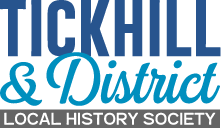

Tickhill Association for the Prosecution of Felons
While researching the background of solicitor William Popplewell for a future Occasional Paper, it emerged that William belonged to two organisations: the Tickhill Association for the Prosecution of Felons and the Tickhill Mutual Improvement Society. As nothing was known previously about these organisations, investigations have taken place resulting in this page and the following one, to make a start understanding their activities.
The precursor of the Tickhill Association for the Prosecution of Felons began in the last quarter of the 18th century and was known as the Strafforth and Tickhill Association for Prosecuting Stealers of Horses. This suggests that attempts to steal horses were likely to be a regular occurrence. Horses trained to plough, pull carriages and wagons, hunt, hack or race would have been valuable property. The organisation broadened to cover all felons in the 19th century and focussed on Tickhill. However, membership of the Tickhill Association for the Prosecution of Felons attracted people from a wide area. For example, in 1870 when notice of the AGM was published in the Doncaster Gazette, on 30 December, 41 members lived in such places as Austerfield, Bawtry, Everton, Finningley, Loversall, Misson, Osberton and Rossington. The leading members were the Earl of Scarbrough, Mrs Miles from Firbeck Hall, Mr Whittaker of Hesley Hall and Major John St Leger of Park Hill. The members who lived in Tickhill, apart from William Popplewell, were mainly farmers: Messrs Hopkinson, Keyworth, Marriott, Nicholson and Smith.
How did the Tickhill Association operate? First, members met once a year at the AGM to ensure agreement about the Association’s finances and activities. The meeting on 6 January 1871 was held at the Red Lion at midday and was followed by dinner at 2 pm combining business with a social occasion. All members were expected to attend, in part to pay their subscriptions, hence their names were listed in the newspaper notice of the meeting. It is possible that there was a sliding scale of subscriptions according to the wealth of each member. Members also had to elect a committee who would decide how much to spend on specific cases.
One of the Association’s functions was to offer rewards for information leading to the prosecution of felons at a time when the police force was in its infancy. It was only after 1856 that every county and borough had to maintain its own police force through local taxation. A particular problem in rural areas was the malicious setting on fire of harvested crops. This was probably the favoured revenge of a disgruntled farm worker. In 1834 the Tickhill Association contributed to a reward for helping to find the culprit responsible for a stack fire near Roche Abbey (five other stacks were saved thanks to the crew of the Firbeck fire engine). In 1847 £10 was offered to find who had stolen two horses from a farm at Gildingwells.
The Association was also involved in the prosecution of felons at the Assizes and at the Quarter and Petty Sessions. Police took on responsibility for prosecuting criminal cases only from the 1870s. Associations were able to recover some of the costs of prosecutions from county rates. The following examples for the Tickhill Association are taken from the ‘Report of the commissioners for inquiring into county rates and other matters’ (Parliamentary Papers vol. 27), HMSO, 1836.
Assizes: Number of prosecutions charged upon the Association’s funds in 1832 – 0, 1833 – 1, 1834 – 0. For the one case taken to the Assizes the Association spent £15/6/10 and received £6/17/10 from the county rate in respect of this expenditure.
Sessions: Number of prosecutions charged upon the Association’s funds in 1832 – 4, 1833 – 1, 1834 – 1. In 1832 the association expended £20 and received £8/2/8 from the county rate in respect of this expenditure. In 1833 the expenditure was £2/11/8 with 17/2 received from the county rate, while in 1834 the one case saw £5/5/10 expended and £8/12/6 received from the county rate. It is not clear why the county’s contribution exceeded expenditure in 1834.
The Tickhill Association could be compared with Sheffield’s Association for the Prosecution of Felons and Receivers of Stolen Goods essentially serving people with shops, inns, and manufacturing businesses and founded in 1804 to combat repeated crimes. A poster for this association from 1837 shows a much larger membership than Tickhill’s Association – 143 members of whom four were women. In Sheffield members had to pay a £1 joining fee and then a 10 shillings annual subscription. They had to meet once a year in March to elect a committee, 10 people in 1837. A scale of fees was agreed, for example, how much witnesses should receive. They were allowed 10 shillings per day to attend Sessions in Doncaster, Pontefract and Rotherham and the same to attend Assizes in York. For attendance at Sheffield Sessions witnesses were paid 7/6 per day. Further payment was given to cover travelling expenses. Constables were paid 7/6 per day to attend Sheffield Sessions and 15 shillings per day if they went to trials in Doncaster, Pontefract, Rotherham and York.
In the long run the emergence of police forces made the need for associations for the prosecutions of felons unnecessary. They had played their part in bringing offenders to justice and possibly discouraging some potential offenders, thus contributing to public order.
For more details see: Koyama, M., ‘Prosecution Associations in Industrial Revolution England: Private providers of public good’ in The Journal of Legal Studies, Vol. 41, no. 1, January 2012, pages 97-130.